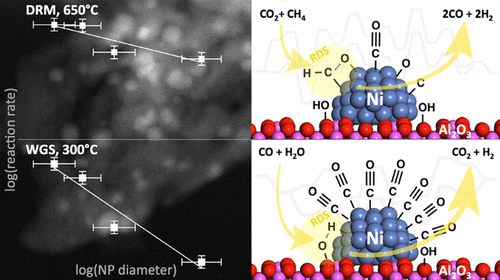当前位置:
X-MOL 学术
›
J. Am. Chem. Soc.
›
论文详情
Our official English website, www.x-mol.net, welcomes your
feedback! (Note: you will need to create a separate account there.)
Contrasting the Role of Ni/Al2O3 Interfaces in Water–Gas Shift and Dry Reforming of Methane
Journal of the American Chemical Society ( IF 14.4 ) Pub Date : 2017-11-14 00:00:00 , DOI: 10.1021/jacs.7b08984 Lucas Foppa 1 , Tigran Margossian 1 , Sung Min Kim 2 , Christoph Müller 2 , Christophe Copéret 1 , Kim Larmier 1 , Aleix Comas-Vives 1
Journal of the American Chemical Society ( IF 14.4 ) Pub Date : 2017-11-14 00:00:00 , DOI: 10.1021/jacs.7b08984 Lucas Foppa 1 , Tigran Margossian 1 , Sung Min Kim 2 , Christoph Müller 2 , Christophe Copéret 1 , Kim Larmier 1 , Aleix Comas-Vives 1
Affiliation

|
Transition metal nanoparticles (NPs) are typically supported on oxides to ensure their stability, which may result in modification of the original NP catalyst reactivity. In a number of cases, this is related to the formation of NP/support interface sites that play a role in catalysis. The metal/support interface effect verified experimentally is commonly ascribed to stronger reactants adsorption or their facile activation on such sites compared to bare NPs, as indicated by DFT-derived potential energy surfaces (PESs). However, the relevance of specific reaction elementary steps to the overall reaction rate depends on the preferred reaction pathways at reaction conditions, which usually cannot be inferred based solely on PES. Hereby, we use a multiscale (DFT/microkinetic) modeling approach and experiments to investigate the reactivity of the Ni/Al2O3 interface toward water–gas shift (WGS) and dry reforming of methane (DRM), two key industrial reactions with common elementary steps and intermediates, but held at significantly different temperatures: 300 vs 650 °C, respectively. Our model shows that despite the more energetically favorable reaction pathways provided by the Ni/Al2O3 interface, such sites may or may not impact the overall reaction rate depending on reaction conditions: the metal/support interface provides the active site for WGS reaction, acting as a reservoir for oxygenated species, while all Ni surface atoms are active for DRM. This is in contrast to what PESs alone indicate. The different active site requirement for WGS and DRM is confirmed by the experimental evaluation of the activity of a series of Al2O3-supported Ni NP catalysts with different NP sizes (2–16 nm) toward both reactions.
中文翻译:

对比Ni / Al 2 O 3界面在甲烷的水煤气变换和干重整中的作用
过渡金属纳米粒子(NPs)通常负载在氧化物上以确保其稳定性,这可能导致原始NP催化剂反应性的改变。在许多情况下,这与在催化中起作用的NP /载体界面位点的形成有关。与DNP衍生的势能表面(PES)相比,与裸露的NP相比,经实验验证的金属/载体界面效应通常归因于更强的反应物吸附或它们在此类位点上的易活化性。然而,特定反应基本步骤与总反应速率的相关性取决于反应条件下的优选反应途径,这通常不能仅基于PES来推断。因此,我们使用多尺度(DFT /微动力学)建模方法和实验来研究Ni / Al的反应性2 O 3与水煤气变换(WGS)和甲烷干重整(DRM)交界面,这是两个具有基本步骤和中间体的关键工业反应,但保持在明显不同的温度下:分别为300和650°C。我们的模型表明,尽管Ni / Al 2 O 3提供了更有利的反应途径界面,这些位点可能会或可能不会影响整体反应速率,具体取决于反应条件:金属/载体界面为WGS反应提供活性位点,充当含氧物质的储存库,而所有Ni表面原子均对DRM具有活性。这与单独的PES所表明的相反。通过实验评估一系列具有不同NP尺寸(2–16 nm)的Al 2 O 3负载的Ni NP催化剂系列对两个反应的活性,证实了WGS和DRM具有不同的活性位点要求。
更新日期:2017-11-16
中文翻译:

对比Ni / Al 2 O 3界面在甲烷的水煤气变换和干重整中的作用
过渡金属纳米粒子(NPs)通常负载在氧化物上以确保其稳定性,这可能导致原始NP催化剂反应性的改变。在许多情况下,这与在催化中起作用的NP /载体界面位点的形成有关。与DNP衍生的势能表面(PES)相比,与裸露的NP相比,经实验验证的金属/载体界面效应通常归因于更强的反应物吸附或它们在此类位点上的易活化性。然而,特定反应基本步骤与总反应速率的相关性取决于反应条件下的优选反应途径,这通常不能仅基于PES来推断。因此,我们使用多尺度(DFT /微动力学)建模方法和实验来研究Ni / Al的反应性2 O 3与水煤气变换(WGS)和甲烷干重整(DRM)交界面,这是两个具有基本步骤和中间体的关键工业反应,但保持在明显不同的温度下:分别为300和650°C。我们的模型表明,尽管Ni / Al 2 O 3提供了更有利的反应途径界面,这些位点可能会或可能不会影响整体反应速率,具体取决于反应条件:金属/载体界面为WGS反应提供活性位点,充当含氧物质的储存库,而所有Ni表面原子均对DRM具有活性。这与单独的PES所表明的相反。通过实验评估一系列具有不同NP尺寸(2–16 nm)的Al 2 O 3负载的Ni NP催化剂系列对两个反应的活性,证实了WGS和DRM具有不同的活性位点要求。









































 京公网安备 11010802027423号
京公网安备 11010802027423号